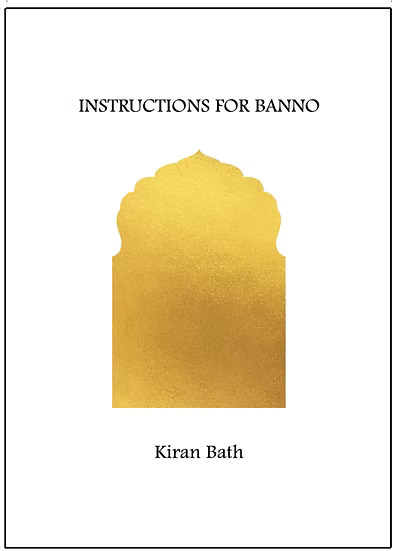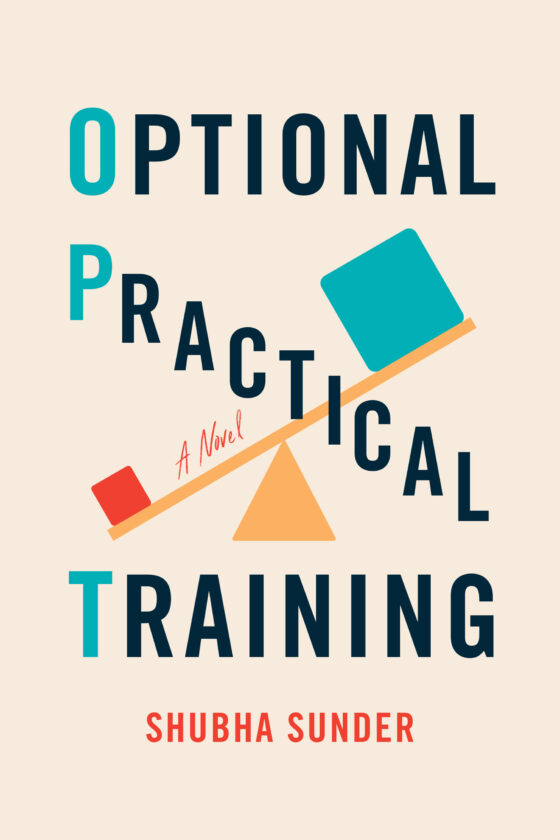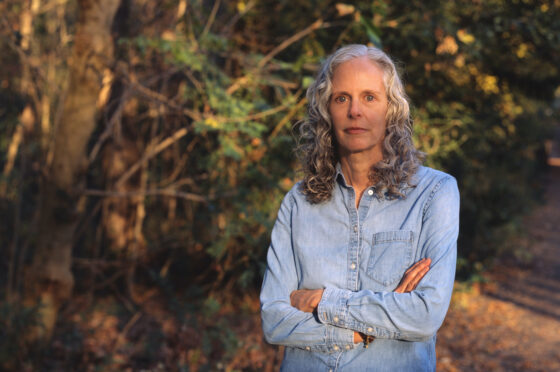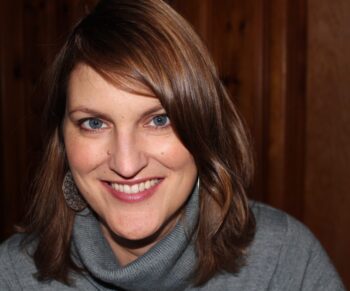
Kelcey Parker had a killer debut with her 2011 story collection For Sale by Owner, winner of the Next Generation Indie Book Award, and we’ve had some good conversations about the experience of writing historical figures as fictional characters. So I tore into her new novel, Liliane’s Balcony, with real anticipation, and I wasn’t disappointed. I read it in the space of one transfixed day, fully immersed in its shifting voices and its sly narrative play.
Liliane’s Balcony is set at Frank Lloyd Wright’s Modernist masterpiece Fallingwater, and it has a great time playing with the Modernist ideas that propelled Wright. Its focus is not on the architect, however, but on Fallingwater’s first owner, Liliane Kaufman, who, with her husband Edgar, made a small fortune from their Pittsburgh department store and commissioned the house they thought would be worthy of their social status. Instead, as Edgar’s travels and infidelities tormented her, it became the site of Liliane’s suicide.
For all its haunted-ness, though, Liliane’s Balcony is not at all a grim or even a sad novel, nor is it—despite its smart tangoes with Wright—a Modernist work. Parker alternates Liliane’s biography with the fictional stories of four present-day tourists who come to ogle Fallingwater, reveal their own emotional turmoil, and collide with each other (sometimes literally and often comedically). It is completely up-to-the-minute in its contemplation of the relationship between fiction and nonfiction, the glitter of the wealthy and their toys, the mysteries of nature and art. The novel is also as intricately structured as Fallingwater itself, and that’s where my conversation with Kelcey began.
***
The Rumpus: Novelists are always talking about the “architecture” of their work, and you make it clear in your author’s note that you see this book’s form as “analogous to that of Fallingwater.” Your description of Liliane’s story serving as the core of the novel, the way the stone chimney serves as Fallingwater’s core, and your observation that the other characters’ sections extend like “multiple cantilevered balconies,” both make it clear how purposeful the structure of the story is. Exactly how pre-planned was your structure? Which sections presented themselves spontaneously? How much back-to-the-drawing-board did you do?
Kelcey Parker: One of the famous stories told about Fallingwater is that, after several planning meetings and visits to the site at Bear Run, Frank Lloyd Wright received a call from E.J. Kaufmann, who said that he was in Milwaukee for business and would be at Taliesin in a few hours. He was looking forward to seeing the designs for the country house. The story goes that Wright hung up the phone, sat down at his desk, and drew the complete plans for Fallingwater from scratch. When Kaufmann arrived hours later, Wright rose from his chair, shook Kaufmann’s hand, and said, “Welcome, E.J., we’ve been expecting you.”
All of which is to say that the design of Fallingwater seems both a spontaneous, organic thing and a result of years of study and experience. This book is one of the few things I’ve ever written that felt like it emerged in its proper form from the very beginning. For the first time, I was relying on a bit of experience as a writer, and part of that experience allowed me to trust that it was okay to just write and see what happened. I wrote the modern-day sections at the same time that I was reading and doing research about Liliane, and the stories and structure emerged together.
Rumpus: It also seemed to me that the structure of the book was very self-consciously capital-M Modernist, and I thought I detected at least a hint of homage to Faulkner’s As I Lay Dying, especially in the effect of Liliane’s ghostly presence hovering over the living the way Addie’s presence hovers in As I Lay Dying. There’s also a hint in some of the voices of those wonderfully sharp, witty, pithy writers of the ’30s, from Katherine Anne Porter to Dorothy Parker. Did you find yourself contemplating any writers of the ’30s as you worked to get those narratives of the past right?
Parker: I’m so steeped in the capital-M Modernists that I think I lack some self-consciousness about how much my work is shaped by that sensibility. I became an English major after enrolling in a course on British Modernism as a college freshman. We read Woolf, Conrad, Eliot, Pound, Joyce, and Yeats, and I recall the strange sensation of being captivated by language structures that I hardly understood: Big Ben struck the half hour. A crowd flowed over London Bridge. Surely the Second Coming is at hand. I’ve been hooked ever since.
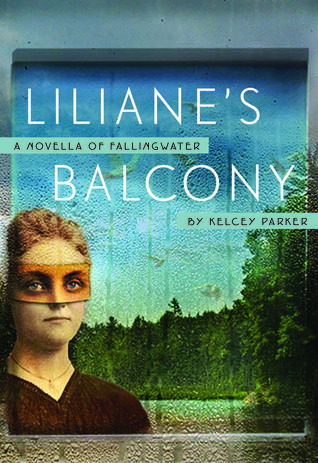 I guess I always want to do what Virginia Woolf says she does in Mrs. Dalloway: “I dig out beautiful caves behind my characters…The idea is that the caves shall connect, & each comes to daylight at the present moment.” As I tried to figure out what my characters’ stories were and why they had come to Fallingwater, it definitely felt like cave-digging (or, the closest I’ll ever come to it), and I love the idea of the caves of my characters connecting and coming to light on their shared tour of Fallingwater. The cave imagery works with the house too, as Wright was very interested in making the house feel like a cave-like refuge with its narrow hallways lined in stone quarried downstream.
I guess I always want to do what Virginia Woolf says she does in Mrs. Dalloway: “I dig out beautiful caves behind my characters…The idea is that the caves shall connect, & each comes to daylight at the present moment.” As I tried to figure out what my characters’ stories were and why they had come to Fallingwater, it definitely felt like cave-digging (or, the closest I’ll ever come to it), and I love the idea of the caves of my characters connecting and coming to light on their shared tour of Fallingwater. The cave imagery works with the house too, as Wright was very interested in making the house feel like a cave-like refuge with its narrow hallways lined in stone quarried downstream.
In terms of American Modernists, yes: Faulkner. As I Lay Dying was important to me in my development as a writer, and it’s only as I think about your question that I realize how much it probably informed this book. Not only with Liliane’s ghostly presence, which you point out, but in the related story of the daughter’s future lost love—a subplot drawn from my own experience that I’ve tried to write about for years. And of course the different characters and voices.
Rumpus: Liliane is very much a constrained woman of her time, and her sections are all the more heartbreaking for their restraint. The idea of “less is more” seems to inform all the stories in your collection For Sale By Owner, and this novella too, in which the present-day characters’ lives are suggested with a few key details, rather than detailed explorations. Those minimal details pack a lot of punch. Can you talk about how that impulse not to overwrite informs even the blank pages of this book?
Parker: Isn’t it so hard to know how much to include? After the first draft was written, I spent two months signed up with a daily writing group and wrote many additional sections of backstory, cave-digging to learn more about character, and ultimately left most of it out. I found and transcribed hundreds of pages of letters but only used a select few of them.
Each book or story has its own set of rules, and writers always have to lay the ground rules and make decisions accordingly. For this book I looked again to the source of inspiration—Fallingwater, with its combination of clean minimalism and intricate details—and decided to keep the focus on the intensity of the moment (as informed by the past, of course). Liliane got a bit more juice, obviously, but even there, I wanted to pursue the intensity and restraint of flash.
Rumpus: The restraint sometimes even extends to not naming characters—Frida Kahlo is never introduced by name, and several characters (the man, the daughter, the date) are left nameless for most or all of the narrative, suggesting archetypal presences and a conceptual framework. Yet the story is certainly as emotional as it is intellectual or theoretical. Would you describe how the balance between the conceptual and the emotional worked itself out as you wrote and how you conceive of the tension between those two impulses more generally?
Parker: My conceptual choice was actually driven by an emotional impulse: I was bothered by the fact that Liliane Kaufmann, who is such a primary figure at Fallingwater, is ultimately such a small part of the histories and narratives that I was researching. I wanted this to be her story. Early on in the writing process I made a conscious decision that it would be her name that was emphasized and repeated, and that the names of her husband Edgar and Frank Lloyd Wright would be implied rather than stated. Even Frida Kahlo’s name seemed like it might distract readers. Not to mention that Frida was not yet Frida in the way we now think of her.
And yes, there are those three other characters whose names don’t come forth until what I suppose is the moment of truth for each of them. When Janie is finally honest with her husband, for example, she no longer addresses him as “the man,” but calls him by his name. When the daughter passes out and encounters the ghosts, her parents call her by name. And even the “motherfucker” who stood Amanda up on their weekend date eventually gets his actual name.
Rumpus: With all this emphasis on how you conceptualized the book, I’d better ask: what elements of the story took you completely by surprise in the writing?
Parker: One surprise was when the ghost of the daughter’s future love appeared. In retrospect, it’s not that surprising, as this is something I have tried and failed to write about for years: my own high school boyfriend and first love who died at age twenty-nine. Though we started dating sophomore year, I met him when I was twelve, which is the daughter’s age, and it’s such a strange thing to be in my forties and to hold all three time periods together in my mind: the time before I ever knew him, the time we spent together as a couple and as friends, and the time since he died. All of which corresponds to what Neil Levine says about Fallingwater in “The Temporal Dimension of Fallingwater,” which I was reading at the time: “The question one constantly asks is not where this or that begins or ends, but when. And the answer is never.” When the daughter passes out, past, present, and future intersect in her encounter with her doomed future love and then with the ghost of Liliane.
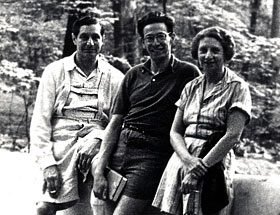 The other surprise was discovering the letters that Edgar wrote to Liliane from his military tour in Camp Taylor, Kentucky. The letters shifted my way of thinking about their relationship—and thus about the story I was telling. Until I read those letters I honestly wasn’t sure if their marriage was more about merging shares in the department store than about a marriage of true minds. The letters, which, alas, are only one-way—from Edgar to Liliane—reveal Edgar’s warmth and affections for Liliane (“my only love”), but they also reveal his bad behavior (“what a rotter I have been”) along with his sense that she was not happy (“Please be happy.” “Keep well and be happy.” “Smile and be happy, you know we both need it”).
The other surprise was discovering the letters that Edgar wrote to Liliane from his military tour in Camp Taylor, Kentucky. The letters shifted my way of thinking about their relationship—and thus about the story I was telling. Until I read those letters I honestly wasn’t sure if their marriage was more about merging shares in the department store than about a marriage of true minds. The letters, which, alas, are only one-way—from Edgar to Liliane—reveal Edgar’s warmth and affections for Liliane (“my only love”), but they also reveal his bad behavior (“what a rotter I have been”) along with his sense that she was not happy (“Please be happy.” “Keep well and be happy.” “Smile and be happy, you know we both need it”).
Even in his earliest memories of her, he recalls feeling “shy and distant before her, for she seemed herself to be remote, to resent intrusion.” Before I read the letters, I imagined that Liliane slowly shut down over years of betrayals, but these letters, from the first decade of their marriage, suggest to me that, even from the beginning, she was already reserved and closed off in ways that perhaps even she couldn’t control.
Rumpus: The letters are a marvel: of tenderness, of frankness, of guilt, of neediness, of manipulation. They are so beautifully integrated into the other narratives that I wasn’t sure whether they were imagined until I came to your notes at the end of the story. At what point in the writing did you find the letters, and at what point did you decide which ones to use?
Parker: It was rather late in the writing process. I already had the contract with Rose Metal Press and was working on revisions when I found the letters. I came across them the old-fashioned way: via a Google search. It felt serendipitous because the letters were held at an archive in Cincinnati that I had walked past every day, to and from my classes at the University of Cincinnati a few years earlier. I was living in South Bend when I learned about the archive, but I had a trip to Cincinnati planned in just a few weeks.
I spent a long and wonderful Saturday morning at the archive in my old neighborhood. I brought my iPhone and took a picture of every page of every letter in that file—nearly 300 photos. I got to know Edgar’s handwriting intimately as I transcribed the text of each of those 300 images. As I typed, I soaked it all in—his words, his tones, his reports of his daily duties and achievements in the military. I highlighted sections I thought I might use in the book, and then I returned to the manuscript and made selections about which letters would stand alone and which would be worked into Liliane’s narrative sections. I wish I could have used all of them!
Rumpus: The movement back and forth between the historical past and the imagined present is (forgive me) very fluid—a reader, and at least one of the characters, floats easily between time frames and realities. But there are also sharp contrasts between past and present: the contrast between Liliane’s sophisticated sensibility and the longing for culture that preoccupies the present-day Janie, for example, couldn’t be more striking. (I love the line about Janie, who works at a university and is trying to take enough credits to graduate: “She wanted to get an English degree before all the courses were about graphic novels and vampires.”) There’s an understated but important class-consciousness informing the novella. Given the tightness of the story, did you find yourself having to subdue any impulses to explore wealth or the lack of it more? And a related question: did you find yourself having to tamp down the wealth of historical research that so clearly informs the story?
Parker: Ah yes, poor Janie with her Cracker Barrel meals and administrative job at the public university. Angela with her practical pension plans. And Josiah Quimby with his Harley Davidson, highfalutin vocabulary, and illustrious Mayflower roots. I love that you pick up on this subtle but pervasive theme.
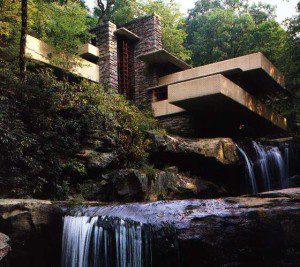 Fallingwater itself—the place, its conception, its stories—strikes me as quintessentially American, particularly in terms of class and economics. A “country house” commissioned in the wake of the Great Depression by the owners of a department store! If the middle class goes to department stores to conspicuously consume, department store owners go to artists and architects. Architects were crucial to creating attractive store interiors that would attract shoppers. They were also the key to showing how well one lived. The Kaufmanns already had one custom-designed house—the architect Benno Janssen designed their French Norman house, “La Tourelle,” as well as the 1930 addition to their department store—and now they would have another.
Fallingwater itself—the place, its conception, its stories—strikes me as quintessentially American, particularly in terms of class and economics. A “country house” commissioned in the wake of the Great Depression by the owners of a department store! If the middle class goes to department stores to conspicuously consume, department store owners go to artists and architects. Architects were crucial to creating attractive store interiors that would attract shoppers. They were also the key to showing how well one lived. The Kaufmanns already had one custom-designed house—the architect Benno Janssen designed their French Norman house, “La Tourelle,” as well as the 1930 addition to their department store—and now they would have another.
But even what you identify as Liliane’s “sophisticated sensibility” is part of her own social climbing. In Fallingwater Rising, Franklin Toker interprets so many of the Kaufmann family’s decisions as obvious attempts to fit in with Pittsburgh’s wealthy gentile set. In the midst of the Great Depression, she conceives of Vendome, the international boutique on the eleventh floor of Kaufmann’s. Ironically, it is Fallingwater—and not the department store—that is the Kaufmann family’s great success.
Fallingwater also happens to be Frank Lloyd Wright’s great comeback story: he was sixty-nine years old and had little work at the time that he was commissioned by the Kaufmanns. Nonetheless, it’s strange to see the letters between Wright and Kaufmann where they both wrangle over expenses and payments.
Rumpus: The last sections of the story are a meditation on “truth” in fiction, and indeed in all art. Again, you quote Wright himself: “The truth is more important than the facts.” It seemed to me throughout that the truth you were interested in was not so much biographical or even artistic, as it was psychological and spiritual—each of the lives you explore here seems consumed by loss and longing. And yet a house, especially a famous house like Fallingwater, so often suggests the opposite: permanence, acquisition, triumphant melding of art and nature. By the end of this story, a reader can certainly understand Liliane’s occupying such a putative symbol of possession and permanence as highly ironic. Would you agree that that’s the kind of truth you’re after here?
Parker: Absolutely. I believe this is what fiction does best: immerses you in the world of a character’s mind. Architecture immerses you in a physical space; film in a visible external world; music in a world of sound; poetry in the world of the poem’s language and images. But fiction and literary nonfiction put you in the mind of character—in her psychological and spiritual “truths”—as she thinks and perceives and interprets and misinterprets and doubts and desires and decides.
I think of the Mary Oliver poem that ends: “Tell me, what is it you plan to do/with your one wild and precious life?” Perhaps all stories are about the moment of figuring out the answer to that question.
Rumpus: The impact of nature on the story can’t be overstated, and it’s another great example of a way you’ve successfully emulated Wright, because nature is always present and crucial without taking over or obscuring the human stories. The scene in which Amanda, whose boyfriend has stood her up, rides the rapids and gets thrown from her raft is one of the most visceral in the novel. I hope you can describe how you handled moving from interiors to exteriors, and whether you found writing some of the exterior scenes (on the bridge, for example) as crucial for writing the domestic interiors.
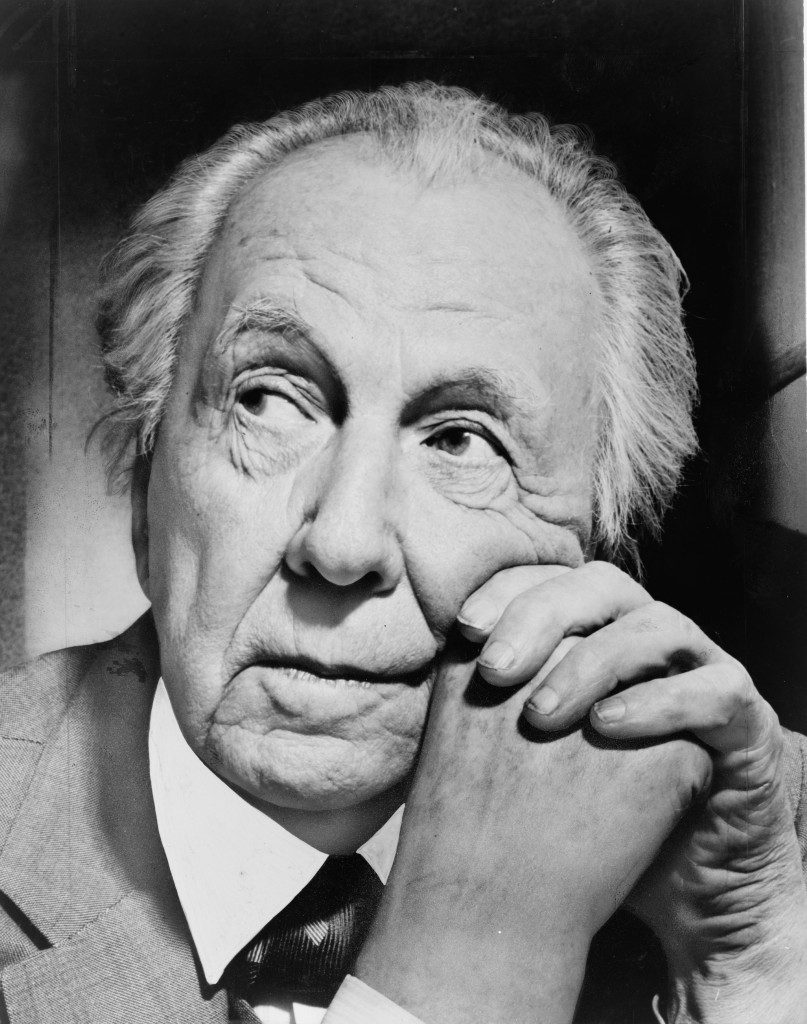 Parker: Wright was born in 1867 and hugely inspired by the capital-R Romanticists of the early 19th century, the ones that promoted emotional and aesthetic experiences inspired by confrontations with wild nature. Sturm und Drang, baby. In old school Romanticism, which is linked to the Gothic, the images are often of steep cliffs, dark skies, and thrashing waters. Mild beauty is contrasted with the intensity of the sublime; fear is contrasted with the superior experience of terror.
Parker: Wright was born in 1867 and hugely inspired by the capital-R Romanticists of the early 19th century, the ones that promoted emotional and aesthetic experiences inspired by confrontations with wild nature. Sturm und Drang, baby. In old school Romanticism, which is linked to the Gothic, the images are often of steep cliffs, dark skies, and thrashing waters. Mild beauty is contrasted with the intensity of the sublime; fear is contrasted with the superior experience of terror.
Fallingwater’s drama is based on the tension between its cliff-like cantilevers and its comforting, cave-like interior; between its roaring waterfall and its cozy fireplace.
When Amanda goes whitewater rafting with strangers, she is at the mercy of the rocks and rapids. Yes, they wear lifejackets, and yes there are experienced guides, but also, yes, people have died in that particular spot doing what she is doing. But that sort of emotional experience is, in terms of Romanticism, also an aesthetic experience, and it empowers Amanda in a way that she can draw on afterward on the balcony of Fallingwater.
Rumpus: The Frank Lloyd Wright line near the end of the book—“The present is the ever moving shadow that divides yesterday from tomorrow”—couldn’t be more apt. Any present impulses to tackle postmodern architecture in narrative form?
Parker: Why not? Maybe I’ll set my next project at Frank Gehry’s Dancing House in Prague (a city that is the setting of two of my other book projects). Gehry’s building was commissioned by the U.S. as an apology for accidentally bombing the original buildings during WWII. Also known as “Fred and Ginger,” one curvy building looks to be leaning into its more angular partner. Perhaps the plot of my story will be that all the residents are trapped in this building that won’t…stop…dancing…

